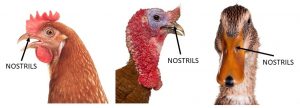Written by: Dr. Jacquie Jacob, University of Kentucky
Although birds have nostrils, most species do not have a good sense of smell. The sense of smell is well developed in kiwis, vultures, albatrosses, and petrels, but is only moderate in fowl, pigeon, and most birds of prey.

A chick’s response to olfactory stimuli (smells) can be influenced before the chick hatches. For example, when an embryo is exposed to smells from day 15 of incubation, the chick will have an increased preference for that smell. In a study, chicken embryos were exposed to the smell of strawberries when the odor was released into the air around the egg in the incubator, rubbed on the eggshell, or injected into the air cell. The resulting chicks preferred strawberry-scented shavings and strawberry-flavored water. Chicks that were not exposed to the smell stayed away from the strawberry-scented materials. This phenomenon called prenatal chemosensory learning can also occur in mammals, fish, amphibians, and insects.
Recent studies indicate that the social behavior of wild birds is influenced by olfactory cues. During reproductive seasons, the chemical composition of the uropygial gland (preen gland) secretion has been observed to change. Male chickens prefer to mate with hens that have intact uropygial glands more than hens that have had the gland surgically removed. Hens show no preference in their responses to males.

